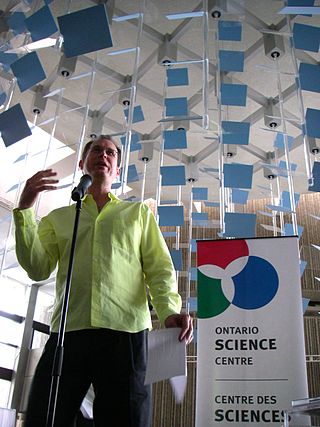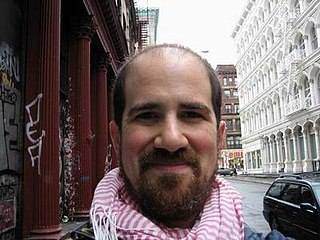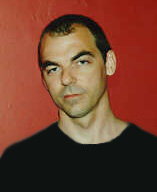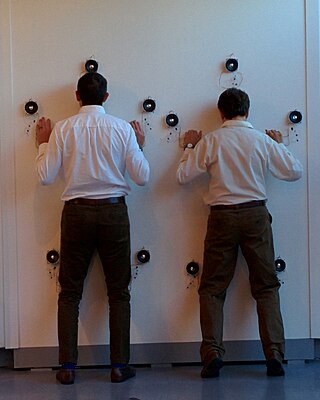
Electronic art is a form of art that makes use of electronic media. More broadly, it refers to technology and/or electronic media. It is related to information art, new media art, video art, digital art, interactive art, internet art, and electronic music. It is considered an outgrowth of conceptual art and systems art.

Manfred Mohr is a German artist considered to be a pioneer in the field of digital art. He has lived and worked in New York since 1981.

David Rokeby is a Canadian artist who has been making works of electronic, video and installation art since 1982. He lives with his wife, acclaimed pianist Eve Egoyan, in Toronto, Canada.

Stelarc is a Cyprus-born Australian performance artist raised in the Melbourne suburb of Sunshine, whose works focus heavily on extending the capabilities of the human body. As such, most of his pieces are centred on his concept that "the human body is obsolete". Until 2007 he held the position of principal research fellow in the Performance Arts Digital Research Unit at Nottingham Trent University in Nottingham, England. He is currently furthering his research at Curtin University in Western Australia.
Roland Brener was a South African-born Canadian artist.
Kenneth E. Rinaldo is an American neo-conceptual artist and arts educator, known for his interactive robotics, 3D animation, and BioArt installations. His works include Autopoiesis (2000), and Augmented Fish Reality (2004), a fish-driven robot.

Golan Levin is an American new media artist, composer, performer and engineer interested in developing artifacts and events which explore supple new modes of reactive expression.

Zachary Lieberman is an American new media artist, designer, computer programmer, and educator.

Gordon Monahan is a Canadian pianist and composer of experimental music. He has been active since at least 1978. Along with his own work, he has performed works by other composers such as John Cage, James Tenney, Udo Kasemets and Roberto Paci Dalò. He has also created site-specific sound installations. In 1992-93 he was artist-in-residence with the DAAD in Berlin where he lived until 2006.

Internet art is a form of new media art distributed via the Internet. This form of art circumvents the traditional dominance of the physical gallery and museum system. In many cases, the viewer is drawn into some kind of interaction with the work of art. Artists working in this manner are sometimes referred to as net artists.
Robert Adrian (1935–2015), also known as Robert Adrian X, was a Canadian artist who made radio and telecommunications art. Adrian moved from Canada to Vienna, Austria in 1972 where he became known for creating experimental artworks using radio and communications technologies. His work The World in 24 Hours, which connected artists in different cities and continents through telephone lines and radio, is considered to be one of the first experiments in online culture. Adrian is considered to be a pioneer in the field of telecommunications art and media art.
Linda Dement is an Australian multidisciplinary artist, working in the fields of digital arts, photography, film, and writing non-fiction. Dement is largely known for her exploration of the creative possibilities of emergent technologies such as the CD-ROM, 3-D modelling, interactive software, and early computing.
Laura Kikauka is a Canadian installation and performance artist. Kikauka is known for her sculptural installations and performances incorporating found objects and electronics.

Ars Electronica Linz GmbH is an Austrian cultural, educational and scientific institute active in the field of new media art, founded in Linz in 1979. It is based at the Ars Electronica Center (AEC), which houses the Museum of the Future, in the city of Linz. Ars Electronica's activities focus on the interlinkages between art, technology and society. It runs an annual festival, and manages a multidisciplinary media arts R&D facility known as the Futurelab. It also confers the Prix Ars Electronica awards.

Bill Vorn is a Canadian artist, musician and professor known for his robotic artworks. Vorn was also a member of the band Rational Youth from 1981 to 1983.

Diana Burgoyne is a Canadian artist known for her installations and performance works using handmade electronics.
Doug Back is a Canadian media artist.

Luc Courchesne D.F.A. (1952) is a Canadian artist and academic known for his work in interactive art.

Nancy Evelyn Paterson (1957–2018) was a Canadian artist and writer known for her work in new media. She was an associate professor at the Ontario College of Art and Design University from 1990 to 2018, and was Facilities Coordinator at Charles Street Video, a non-profit, artist-run centre providing production and post-production facilities for digital video and audio.
Tom Sherman is an American-Canadian artist working in video, audio, radio, performance, sculpture and text/image. He is also a writer of nonfiction and fiction. He is a recipient of Canada's Governor General's Awards in Visual and Media Arts. He is a professor of video art at Syracuse University.














